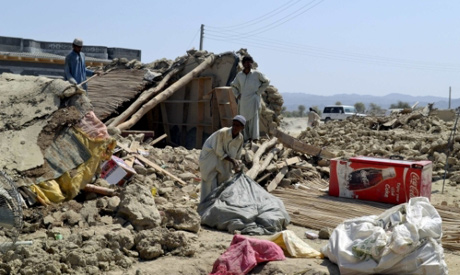
Survivors collect their belongings near the rubble of a mud house after it collapsed following an earthquake in the town of Awaran, southwestern Pakistani province of Baluchistan, September 25, 2013.(Photo: Reuters)
Hungry survivors dug through rubble to find food and thousands of survivors slept under the open sky or in makeshift shelters for a second night as the death toll from Pakistan's massive earthquake rose to 348 on Thursday.
Rescuers battled to reach remote areas of the impoverished region in the wake of Tuesday's magnitude 7.7 quake in southwestern Baluchistan province.
The quake had flattened wide swathes of Awaran district where it was centered, leaving much of the population homeless.
The spokesman for the provincial government, Jan Mohammad Bulaidi, said 348 people have been confirmed dead so far and 552 people had been injured.
"We need more tents, more medicine and more food," Bulaidi said earlier.
In the village of Dalbadi, almost all of the 300 mud-brick homes were destroyed. Noor Ahmad said he was working when the quake struck and rushed home to find his house leveled and his wife and son dead.
"I'm broken," he said. "I have lost my family."
Doctors in the village treated some of the injured, but due to a scarcity of medicine and staff, they were mostly seen comforting the survivors.
Awaran district is one of the poorest in the country's most impoverished province. Many people use four-wheel-drive vehicles and camels to traverse the rough terrain.
Houses made of mostly mud and handmade bricks in the quake-affected region stood little chance against the massive quake. Walls and roofs caved in, and people's possessions were scattered on the ground.
Baluchistan is Pakistan's largest province but also the least populated. Medical facilities are few and often poorly stocked with supplies and qualified personnel. Awaran district has about 300,000 residents spread out over 29,000 square kilometers (11,197 square miles).
Many of the injured were ferried to the port city of Karachi or Quetta, the capital of Baluchistan, for treatment.
One survivor interviewed in his Karachi hospital bed said was working in the fields of his farm when the quake struck.
"Almost all the homes have collapsed in my village," said Sabal Khan. He said his wife was badly injured in the quake.
The local economy consists mostly of smuggling fuel from Iran or harvesting dates.
The area where the quake struck is at the center of an insurgency that Baluch separatists have been waging against the Pakistani government for years. The separatists regularly attack Pakistani troops and symbols of the state, such as infrastructure projects.
It's also prone to earthquakes. A magnitude 7.8 quake centered just across the border in Iran killed at least 35 people in Pakistan last April.
Tuesday's shaking was so violent it drove up mud and earth from the seafloor to create an island off the Pakistani coast.
The director of the National Seismic Monitoring Center, Zahid Rafi, said such masses are sometimes created by the movement of gases locked in the earth that push mud to the surface but scientists are still trying to determine what happened.
Officials warned residents not to visit the island because it was emitting dangerous gases. But dozens of people went anyway on Wednesday, including the deputy commissioner of Gwadar district, Tufail Baloch.
Water bubbled along the edges of the island that smelled of gas, Baloch said. Dead fish floated on the water's surface, and visitors took stones as souvenirs, he added.
Similar land masses appeared off Pakistan's coast following quakes in 1999 and 2010, said Muhammed Arshad, a hydrographer with the navy. They eventually disappeared into the sea during the rainy season.
Short link: